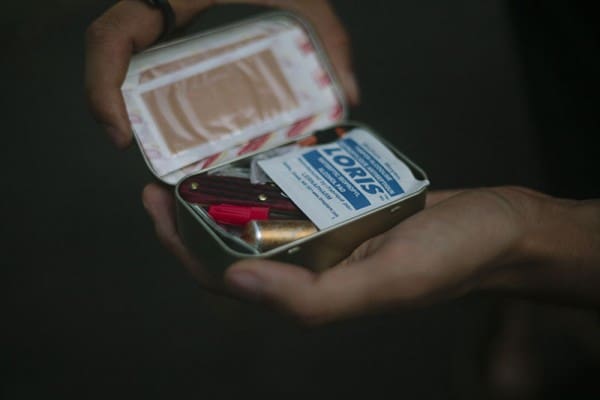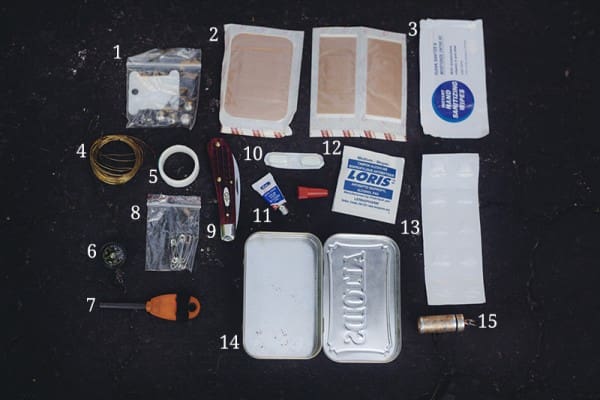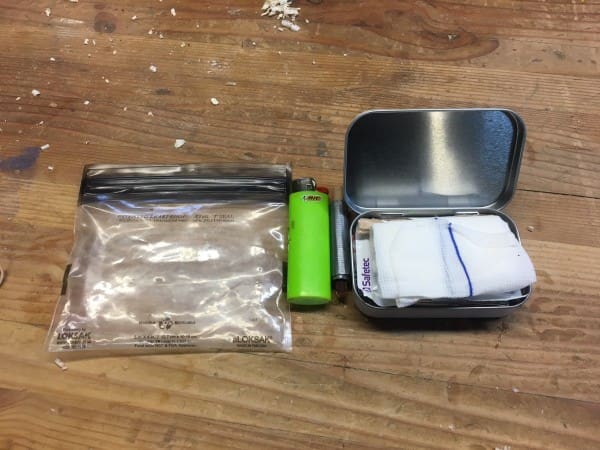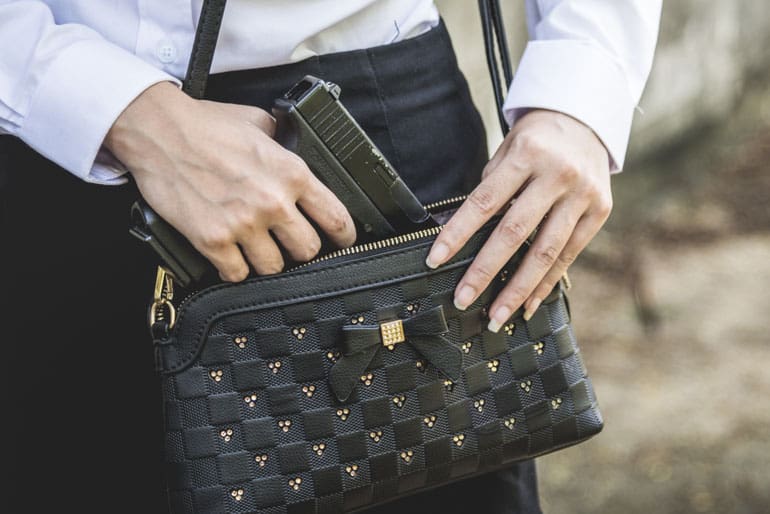
By Clay Aalders (reposted from The Truth About Knives)
I have been toying with the idea of starting a new feature “Survival Saturday” to put a focus on Survival, Bushcraft, and the like. Even a bit of light prepping. Nothing too extreme or focused, rather looking at items and areas that are likely to have a significant overlap with the interests of our readers, even if it isn’t specifically about knives . . .
I admit that part of this is self serving. First, I hate when a knife violence post is on the top of the page. It is also nice to have a theme post for the weekend (like our Sunday Funnies) that I can be on the lookout for over the course of the week. If I am highly motivated, I can even get it written up before the weekend and take a day off.
It is only fitting that we kick things off by sharing a post from our friends at More Than Just Surviving. They are among the handful of sites that are the Gold Standard for the genre. They also do some pretty nice knife reviews as well.
There are many posts about Altoids tins all over the survival-blogosphere. I actually came across one this week that motivated me to kick off this new feature. I just didn’t think it was nearly as good as I the one I remembered from MTJS.
What I really like about Thomas Xavier’s post (he and his wife are the purveyors of MTJS Blog and we are proud to say TTAK readers as well), is that he really explains the “why” of what he is doing:
“The core issue with the pre-assembled crap is primarily this advertising gimmick that’s typically played: packing in more items (in terms of sheer number) than the competition, rather than focusing on providing good tools, even if they’re less in number, that would prove extremely useful in survival situations. A good example would be throwing in a dozen band-aids and a razor blade instead of the far more useful single large wound dressing plus a small quality pocket knife.
Obviously, commercial survival kit assemblers have economic realities and can’t offer the best tools without jacking up the price considerably, but at the end of the day, this is precisely why I encourage everyone to assemble their own survival kits.
All this to say – if you want your own small survival kit, you’re going to want to make it yourself. Not only to save on cost, but also to be able to control the quality of the products that you’re supposed to be trusting your life with!”
Author WEB Griffin once said “The mark of another man’s genius is how much you agree with him”. Let’s just say I consider Thomas and Elise to be Mensa members by this metric. The above blockquote is a good example of why.

Thomas’s kit contains more than a dozen items, including a tiny bit of fishing tackle, super glue, a ferro rod, first aid items and more. Even the tin itself is an item, which can be used for making charcloth for firestarting or used to boil-purify small quantities of water.
I am not going to describe each item in detail, you can see for yourself here. Thomas does a great job of explaining the uses and rationale for each item chosen.
He summarizes his kit thusly:
“The point of a kit like this is to be used – in my opinion. Saving them for an emergency is great. Not using them in an emergency because you’re saving them for a really big emergency – kinda pointless in my opinion. If you need something – use the item and replace it if it was a band aid or pill or something along those lines.
Ate something that’s not sitting well with you? Slip out your emergency Altoids kit and pop an Imodium. Cut yourself accidentally? Clean that cut and bandage it up! Don’t let the cut get infected because you were “saving” the contents of your Altoids tin survival kit for a “bigger emergency.”
Its all about real world situations and being prepared for them. I am a firm believer that having an inconvenient kit, one you wouldn’t want to open and use, is nearly as bad as not having a kit in the first place.
Again, I would rather understand the thought process going into a kit than simply see a list of items. That is why I am sharing this post and not the one that inspired my doing so.
I don’t have a formal survival tin per se. I do carry one full of first aid supplies when I guide or hike, to compliment the much more comprehensive one in my truck. It is stored in a small waterproof pouch with a lighter and the one item that I think I would add to Thomas’s kit.

My kit contains about 2-3 feet of duct tape wrapped around a dowel (at the moment) or preferably a common nail. Thomas’s kit contains first aid tape, but I just think that duct tape is more versatile in any number of situations.
Have you ever made a kit like this? What changes would you make to the MTJS kit?




I do find this interesting.
+1. Something practical and useful once a week would be interesting.
A life hack, with examples of how you can DIY, not a sales pitch for a product.
I third this motion. All in favor?
I like that little Bic a whole lot more than the idea of “tinder”. Hundreds, maybe thousands of lights.
Condoms. Because not every emergency has to be bad.
Yeppers. Condoms give you a nuclear option in a water ballon fight.
The spermicide-coated water balloon c0ckslap.
A classic.
Condoms are actually quite good for a number of… off-label uses.
In my business, all the wireless mic packs go in an unlubed condom for every show. cheap insurance against moisture damage. Sound guys buy them by the case.
The art of manliness actually did a similar article to this some time ago, I’m not going to lie, I kind of want to build the dart launcher
http://www.artofmanliness.com/2011/01/30/22-manly-ways-to-reuse-an-altoids-tin/
I hunt and fish and gold pan and just generally knock about in the woods a bit. I considered one of these tin style kits and quickly discarded it.
In a pouch in the back of my 4runner is my kit. I always, and I mean always, have a folding knife on me. My pouch has a fixed blade, usually a Mora. A bootlace that goes around my kneck has a swedish fire steel and striker with a combi whistle, compass thingy. I also have a throw away lighter and one of those orange waterproof containers with lifeboat matches and a strip of sand paper in it. A headlight and small handheld light, both LED. And a zippered pouch first aid kit that fits in a cargo pocket.
This stuff gets loaded into various pockets and my belt and takes up little space or weight and is much more usefull than the mini items in a tin. Add a little water and some power bars and I’m set for a romp in the woods.
Choice of which firearm to add to the loadout is subject to needs and area.
Tampon on to stuff into s wound
As an idea, one of those emergency cell-phone re-chargers that use replaceable Alkaline AA batteries.
Some spare cash, your lawyer’s phone number…
Those power packs for charging cellphones slowly lose their charge. YMMV. Check at least every 2 weeks. The versions under $10 may not make you happy. I’m looking into the new waterproof solar chargers.
I’m referring to the re-chargers that use AA batteries, not the rechargeable re-chargers.
So is he.
Wait… so altoids tins are good for something other than a dope-stash? Whodathunkit.
Altoids tins make a dandy pocket carrying case for in-ear earphones.
I just went on a 7-hour (round trip) road trip this week. I packed a few items for the 1 in 1 billion chance of an EMP strike that renders automobiles useless.
Here is what I brought:
— small camouflage backpack
— small tarp (6 ft x 8 ft)
— 100 feet paracord
— knife, fixed 5 inch blade with sheeth
— multi-tool
— matches (entire large box of large kitchen matches in ziplock bag)
— disposable cigarette lighter
— fire starter sticks
— megabright LED flashlight with 1+ hour run time on single AA battery
— batteries, AA spares for LED flashlight (quantity of 10)
— large can of baked beans (28 ounce, can doubles for boiling water)
— crackers
— peanuts
— water bottles (16 ounce, quantity of 2)
— water (1 gallon distilled)
— blankets, fleece (quantity of 2)
— sleeping bag (winter weight)
— shoes for hiking long distances
— extra ammunition
Since I was in another person’s vehicle, I forgot to grab these items that I normally keep in my vehicle:
— compass
— fishing line
— basic fishing gear
— rum (1/2 pint for disinfectant and drinking!)
— duct tape
Needless to say, these items do not fit in a small tin. However, all of it does fit into the small backpack with the exception of the blankets and sleeping bag. That is a pretty effective “go bag” that enables survival in just about any conditions for more than two weeks … and almost indefinitely if I can acquire additional food sources.
I have 2 grommet tarps in my 4runner along with blankets. Been mulling adding a mil spec poncho to that.
Oh, I forgot — I did have a moderate quality/strength poncho in the backpack as well. Good call.
My “load out” was pretty simple and probably did not weigh more than 16 pounds (not including the gallon of distilled water). That means I can move as FAST as I want. Personally, I think it is the optimum balance between having enough items to survive a LONG time and being nimble … everything I need and nothing that I do not truly need too survive.
What I don’t understand is why our military doesn’t do the same. I hear about guys with load outs well over 100 pounds … and some approaching 200 pounds. Any supposed rationale that I have heard does not make sense to me. No matter what, our troops need to be nimble, and you cannot be nimble carrying 150 pounds of stuff. It seems to me that the less nimble a squad is, the more stuff they have to carry to defend themselves if they get stuck some place … and they would get stuck because they were not nimble enough. It is a vicious circle. Light and fast is always better. If light and fast will not get the job done, then you need a tank or air power, not 16 guys carrying 150 pounds of stuff each.
The problem that we grunts had was that we carried loads that had no counterpart in the civilian world. Helmets were steel. Body armor was bulky and heavy and not really effective. We carried our weapon(s) and 300+ rounds of ammo PLUS ammo for a machine gun or mortar rounds PLUS m72’s…..It’s endless.
I honestly don’t know what the cure for all that is except to never have a war again. And I don’t think people are capable of the whole peace thing.
jwm,
But would you really need all of that stuff if you were light and fast?
As for stuff like mortars, the simple solution is drones. What is their loiter time these days? Something like 20 hours? All we have to do is add a simple video guidance system to a mortar charge that the drone can drop from on high. Such a simple ordnance would be exceedingly cheap to manufacture and wildly effective. It would also be light and a drone could easily carry 20 of them up in the sky. Once up in the sky, the guys on the ground could call in or even illuminate targets for destruction.
I understand that guys would need something like 300+ rounds. Again, if they are light and fast, they shouldn’t need much more than that. If they find themselves facing a sudden attack with superior numbers — where they would traditionally want mortars, RPGs, grenades, claymors, big machine guns, etc, — instead they can get out of dodge in a hurry (because they are light and fast) all while drones drop mortar rounds from on high to cover their extraction.
Of course my scenario requires close-air support, the ability to insert reinforcements right away, and the ability to extricate/extract right away, but those are not difficult tasks these days with constant communication via drone/satellite, always knowing precise locations via GPS, and the options for mechanized extraction via FAST land based vehicles and fast rotary wing aircraft. (Hint: fast rotary wing aircraft options abound when the guys that you are extracting don’t have thousands of pounds of unnecessary arms, ammunition, and ordnance.)
But what do I know?
Yeah, we didn’t have drones in the day. Things, technology, have changed. And we prepared for the What If scenario. What if the choppers couldn’t get to us. What If will worry your ass when your ass is on the line.
My experience is 4+decades in the past. A lot has changed since then. Maybe the new troops don’t need the burden.
Yes the drone mythology. Brought to you by Obmer the Great.
Already on the fast to failure.
From what I understand most of the weight in modern loadouts is water (a huge portion), ammo, grenades, and shared weaponry (ammo, barrels, etc for a SAW and/or grenade launcher). This stuff is all very necessary unless your proposal is that anyone who ever gets mired down in any way should just go ahead and die. I don’t think I have ever even heard of an infantry soldier/marine who claimed they had too much water or ammo, ever. A few might complain a bit about carrying the shared weaponry stuff, but usually it isn’t that they think it shouldn’t be carried, but, rather, that they wish they were carrying a different portion; they like to carry the ammo, not the barrels, as far as I understand.
The only major loadout weight that may fit into your description that I can think of is body armor. However, while nimble is great, you still can’t dodge or outrun a bullet; permanent casualties, and even more so, deaths have been drastically reduced due to modern armor, so it seems like it is probably worth it.
Duct tape. We always end up breaking open tins (for us, little dry bags) for duct tape. Twice when we lost a tent pole ferrule, we fashioned another out of duct tape. Duct tape, man.
Maxpedition makes a line of 3 or 4 different pocket organizers that are absolutely brilliant for this type of kit. I use the mini and it is always in my pocket. Use it at least 3 or 4 times every day. Have a “Fatty” one for my briefcase and wife’s purse.
A plug for athletic tape: it’s waterproof in the sense that you can wrap it around a bloody/wet gash and it’ll stick to itself better than duct tape. I roll duct tape and athletic tape around a sharpie. Now I have two useful types of tape and a writing utensil (leaving notes, can write on items that a ball point won’t).
Many altoid kits are clever. However I find them limiting, so I do what I have found works better for me.
My family cars are set up to have some basic supplies that can be used and replenished easily
-A case of water in a milk crate
-A weekly pill box, filled and labeled with a different medicine in each day. This is in glove box
-A auto emergency kit (one of those $30ish kits you can get at stores). This and water sit side by side.
-A reused plastic 16 oz peanut butter jar with supplies to deal with minor medical issues, make a fire, and have light. This is placed in the auto bag
-a pencil box filled with granola bars and snacks under front seat.
We often use each of these items and constantly replenish them.
Back in the late 1960’s the Seattle Mountain Rescue volunteers ran a survival course. They had their own version of a survival kit – really a “lost” kit which was oriented around finding yourself lost and helping you get through a night or two in the woods. Tacoma Mountain rescue now sells a very similar kit in part to raise funds. It’s bigger than an Altoids can but I think it’s a better kit. You can see a description of it here:
http://www.tacomamountainrescue.org/survival-kits/
Again, it’s not really an all-purpose survival kit and no substitute for a B.O.B. but it can certainly be at the core of one. It’s intended for lost in the woods or if you somehow get stuck in the woods (someone’s too sick or hurt to walk out, storm comes up, it takes just too long to get back down that mountain, etc.) Everything about the kit is fairly obvious except for the fact that the container needs to be metal and deep enough to hold a cup or two of water while you boil it – especially important if you don’t have any other means of water purification. A substitute might be one of these metal 16oz cups that just fits over a plastic Nalgene bottle. Use the Nalgene bottle to hold the survival kit. Another alternative is a one quart paint can – you can get them empty online though that’s a little bulky.
Empty paint cans are on the shelf at Home Depot, Lowe’s and most any local paint store.
The paint can, IMHO, is really only practical as part of your kit if you have it set up as a hobo stove. I have also looked at Kelly Kettles for my truck kit. Here in CA there’s lots of time and places where an open fire on the ground might be downright dangerous.
Regarding your duct tape: my duct tape (actually Gorilla Tape) dowel is also my sewing kit and writing tool. I cut 2.5″ of Bic pen tube, and stick two thread-wrapped needles in there along with the cut-down ink reservoir. Then re cap and wrap with tape. I’ve seals the end of the ink reservoir with melted paraffin, which I’m not sure will actually work, but we’ll see.
One thread is dark cotton, and the other is nylon for repairs on both gear and people, should the need arise.
Last time I had to fly (I avoid flying whenever possible), I decided I was going to carry as many tools that hit the stretched edge of the TSA’ s (*spit*) idiotic list of permissible itemsas I could. Letterman Style CS, Gerber hook seatbelt cutter, tactical pen, etc. Yes, a bit of a petulant reaction, I know. Whatever.
That turned in to a scavenger hunt for a key-chain based survival kit along the same lines as the Altoids box idea.
Now, find a micro pistol to fit in it.
using modified SERE kits for years ever since the South East Asia War Games!
Altoids can kits are a lot of fun putting together, mostly I have found too many items cumbersome, but basically I have a Mini Bic, 7 Storm Matches, , SE razor Blade, 6′ 100# micro cord, P51 or p38 can opener, 4 Commercial fire starters, 3′ jute string, mirror, Fishing Nail Cutters. 2 Aqua Tabs, 1 UL Condom, 2 alcohol pads, 3”Gause pad , 3 Band-Aids, a needle, 2 paper clips, 2 safety pins, 1 peppermint hard candy! 3 one dollar bills!
Gear on my person Daily, for 40 yeas has been a Small Leather man & belt case, mini Mag and holster, in Left Pants pocket is a 3” Sodbuster, right skirt pocket is a large Bic Lighter wrapped in Duct tape! Left shirt pocket small note book Pen , Ever sharp, followed up with a pocket pistol, spare Mag! This is an emergency get home kit built for a specific distance from home, the Larger ones are more complicated with a wire saw, 18” square of Wax Paper,,
Trick birthday candle, box of SA water proofed matches. 1 cell Mini Mag, 2 buttons, thread wrapped around needle holder. Whistle, Ferrocerium rod, Razor blade box cutter, 10 water tabs, Fishing Kit, hooks, swivels, 30# fishing line, Carpet thread, Brass wire , steel wire, Three 24” steel 30# # leaders {snares}, 4” sharpened hacksaw blade, 1 Emory board! Mini Leather man, 2 electrolyte tabs, 3ft Duct tape, sm magnifying glass space blanket, a little larger Can and a homemade leat carrying case
Also like a Soap Dish with Ranger Bands in a cell phone case for quick attachment to a belt, Go Bag, attack bag, etc. this never leaves my hip until Mission accomplished! even take it on R&R,
Instead of an altoid tin, that weighs over an ounce, I just vacuum seal my kit (s). That awesome tourniquet is 25 bucks and weighs 4 ounces, I add quicklot, gauze. Tape, and one of those injectors for allergies/ aniphilactic shock. So my first aid kit is pocket sized and very light. For vehicles I think a case of bottled water is a no brainer, it’s like 7 bucks at a grover store….
Good survival kit is a must have. The minimum kit should have things that YOU need. Bigger kit will contain things to help others.
Comments are closed.